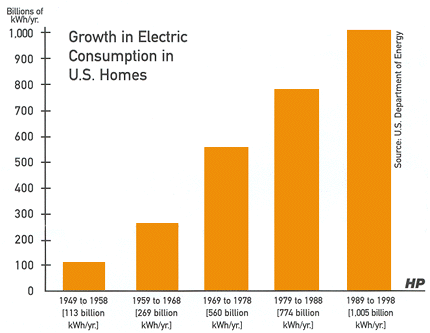Home theaters, home offices, whirlpool tubs, video games, rechargeable tools, appliances and personal computers-the landscape of our lives has changed dramatically in the past few years, reshaped by new and ever more sophisticated electrical products. But our need for increased power to operate these devices has, in many cases, outpaced our homes' ability to serve and protect us.
It's hard to believe that, not long ago, the standard electrical service installed in most homes was only 60 amps (for comparison, consider that many central air conditioning systems alone can draw up to 40 amps, and electric ranges often need 50 amps). But 60-amp service was once considered sufficient power for all of the plug-in appliances and permanently wired fixtures a typical home possessed. Of course, those were also the days before televisions in every bedroom, multiple-computer households, and the proliferation of electric appliances for teenagers to use on their hair.
Today the required minimum for new homes is 100-amp service, according to the current edition of the National Electrical Code. But even this modern "standard" may fall far short of adequate for many families-now, and in the not-too-distant future. "If you're a smart homeowner, you want to go well above the minimums. You want to add more circuits and more capacity," advises David Brender of the Copper Development Association. A member of one of the NEC's Code-making advisory panels, Brender along with other industry experts, helps to review and propose changes that keep the electrical code up to date with improvements in technology and changing lifestyles.

The graph above shows the annual sales of electricity, in billions of kilowatt-hours, to U.S. homes over the past five decades. The trend illustrated shows why most homes built before 1989 are poorly equipped with electric service for today's demands. Brender is quick to point out that like all construction and safety codes, the NEC sets baseline standards only. Homeowners can, and often should, exceed the Code recommendations when they build, repair or renovate.
For example, anyone expanding the electrical capacity in their home would be wise to consider installing a higher-capacity panel-150 or 200 amps-if they have a growing family, or expect further home expansions in the years ahead.
Another smart move is to use 12-AWG copper wiring as a minimum size for all new electrical installations, even for those circuits protected by 15-amp breakers. Although thinner 14-AWG wire is allowed for most residential applications, the heavier 12-AWG wire runs cooler and is more energy-efficient. You'll also benefit right away from the extra margin of safety it provides, and you won't have to run new wiring a second time if the circuit needs to carry more current in the future. (You can simply change-out the breaker from 15 amps to 20 amps.)
According to Brender, even professionals must be encouraged to think ahead when called in to perform routine electrical work. The Code presently allows electricians to calculate a home's power needs (in total watts) by multiplying the living space, or square-foot area, by a factor of three. In Brender's view, increasing that factor by at least 50 percent provides a more realistic margin for anticipated energy use in the years ahead. A recommendation to write this increase into the electrical code has been proposed, but is probably years away from adoption Homeowners who want to upgrade now don't have to wait that long.
